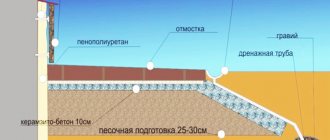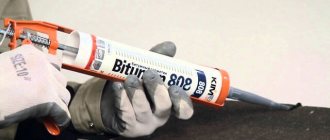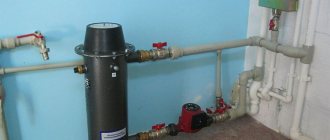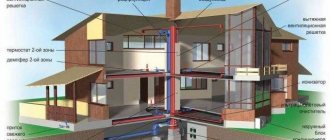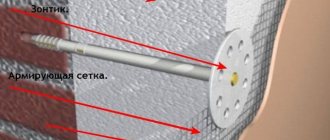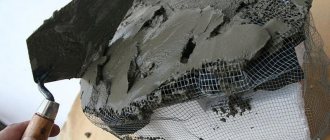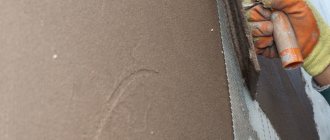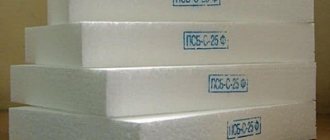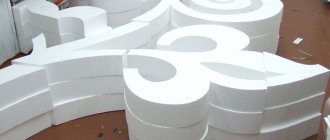Adhesive for extruded polystyrene foam is selected for a specific type of work, taking into account the density of the material that needs to be glued, its type and temperature and humidity conditions during the work and during operation.
For external and internal work, different adhesive compositions are used. In addition, the adhesive for polystyrene foam must have a low thermal conductivity in order not only to adhere polyurethane insulation, but also to help increase the thermal insulation of the entire house.
The concept of polystyrene foam: application of the material
The white material with a cellular structure is commonly called foam plastic. It is produced by foaming plastic masses, so it consists of 98% air. Micropores located throughout the entire area of the material are isolated from each other, so the raw material has thermal insulation characteristics. Polystyrene foam is considered an environmentally friendly material; it has a long shelf life and does not ignite without a fire source. Light weight and low cost are the main advantages of this material.
Experienced craftsmen know how to glue foam plastic, so they use it in the following areas:
- insulation of buildings;
- production of refrigerators;
- protection against freezing of various communications;
- roof insulation;
- use for finishing purposes.
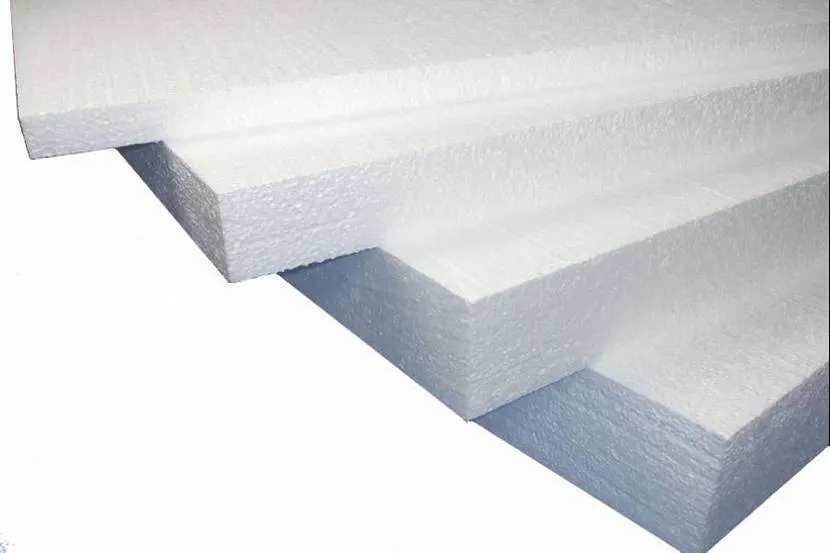
Foam plastic is used for finishing ceilings, walls and other surfaces. It is easy to paint, dries quickly, and does not crack. Cut the material using a sharp stationery or construction knife. It is often used as a base for preparing glue, paint or varnish for concrete or wood.
Attaching heavy objects to plasterboard walls
When decorating the interior of any room (residential, office, etc.), we often face a difficult choice - what to give preference to: functionality or aesthetics? On the one hand, you don’t want to unnecessarily clutter the useful space of a residential building or apartment with unnecessary furniture, but you also want to decorate the room in some way elegantly. But on the other hand, you have to put up with the fact that a lot of things that are used in everyday life will have to be placed somewhere. If the house or apartment has significant dimensions, then solving this dilemma is not difficult. It’s a different matter when the space in the room is very limited.
In some cases, a compromise between the functionality and aesthetics of a room can be found using conventional redevelopment, which, if desired, can be done independently using plasterboard sheets (GCR). It is quite convenient to work with such sheets when constructing almost any spatial structures. Laying tiles on drywall, covering it with wallpaper, applying textured putty, simple painting and other finishing work also does not present any particular difficulties.
Today, drywall is used not only widely, but almost everywhere. It is rare that any modern renovation can be completed without the use of gypsum boards. Today, depending on the operating conditions and the requirements for the room being repaired, ordinary plasterboard, moisture-resistant, fire-resistant and moisture-resistant, is used. Such a fairly wide range of products makes it possible to use plasterboard with equal success in the bathroom, kitchen, living room, bedroom and other rooms with their own specific characteristics.
Sometimes you can hear that drywall should not be used in the kitchen or bathroom. It’s as if even moisture-resistant sheets cannot withstand prolonged exposure to an atmosphere with high relative humidity, and in a kitchen they also absorb odors. Actually this is not true. Moisture-resistant gypsum boards contain special water-repellent additives in the gypsum core, and the construction cardboard, which is the jacket of the gypsum boards, is additionally impregnated with a bactericidal composition, which provides reliable protection against the formation of mold and mildew. In addition, the walls of the bathroom or kitchen are often tiled. Tile on plasterboard provides additional protection to the gypsum board itself, and is also easy to maintain and easy to clean. So, tiles - on drywall installed on the wall, paint on the ceiling, and the ceiling of your bathroom or kitchen under reliable protection from any external influences.
How to combine aesthetics and functionality?
If you have started a renovation and decided to use gypsum boards for these purposes to level the ceiling and walls, you should at the same time pay attention to the decor of the future interior, because plasterboard is an excellent material for constructing various niches, arches, multi-level ceilings, decorative partitions, fireplaces, even plasterboard cabinets and other unusual but original elements of room design.
Some of these bright decorative elements that simultaneously combine functionality and aesthetic properties include niches, shelves, arches, etc. designed for installation of plasma or TFT TVs.
How foam is glued to different surfaces
Depending on the type of work, foam plastic is glued to various surfaces. For example, when fixing to concrete walls, specialists use special foam. Since concrete walls are quite cold, they require insulation, and this material is ideal for this role. Foam glue is suitable when working with brick walls. This composition is a dry mixture, which the master subsequently dilutes with water. Dry mixtures are inexpensive and have low consumption. The specialist applies the finished composition to the wall or to a sheet of material, and the slabs themselves are glued from bottom to top.

Dry construction mixtures are used for gluing Source obystroy.ru
You can use polystyrene foam glue or PVA construction adhesive. It perfectly fixes the material on metal surfaces. First, burlap is impregnated with this composition, applied to a metal surface and waited for drying. As soon as the layer has dried, fix the foam material. In order for the slab to better adhere to the base, after applying it, it is pressed against the wall. At this time, the glue increases its thickness, and the specialist glues the next slab.
Application of polystyrene foam in questions and answers
Where is extruded polystyrene foam used?
Extruded polyester foam is used in:
- Thermal insulation of foundations. Due to the fact that it does not decompose from exposure to soil and does not absorb moisture, it is suitable for these purposes.
- For insulation of floors of lower floors, in “Warm Floor” systems. In this case, the option of using polystyrene foam is almost no alternative.
- Thermal insulation of walls. Use is possible for both external and internal walls, but it is necessary to have ventilation or air conditioning in the room.
- Thermal insulation of roofs and especially flat roofs.
- In thermal insulation of pipelines, many refrigeration units and industrial facilities.
- In the construction of railways and highways. Thanks to the material, freezing of the soil layer is minimized.
Where is it better not to use extruded polystyrene foam:
- It is not advisable to use it for the construction of partitions indoors due to the toxicity of the material when exposed to excessive heating or combustion.
- It cannot be used to insulate the facades of wooden houses due to zero vapor permeability and low adhesive ability.
Is it necessary to glue foam plastic to the walls of the house when covering it with siding?
The use of suspended structures when insulating with foam plastic is possible, but the insulation must be fastened with glue, followed by mechanical fixation with dowels. Glue is used to obtain a uniform connection of the insulation to the wall, a kind of monolith. It is recommended to even apply the sheet to the wall at a distance of about 2 cm from the desired place and then move it with pressure to the desired place. Therefore, this should not be neglected. Fastening with dowels is carried out at the rate of 4 pcs. per square meter, in the area of doorways about 5 - 8 pcs. per square meter.
What thickness of polystyrene foam should be made at a temperature of -40 0 C?
In order to calculate the required thickness of the insulation, you need to use the formula: R = P/K, where P is the thickness of the layer in meters, K is the thermal conductivity coefficient of the insulation, for expanded polystyrene it is 0.031-0.041 W/m2. The exact value depends on the density of the sheet.
R - thermal resistance coefficient is taken from the table for the region.
| City | Average temperature of the heating period 0 C | Thermal resistance coefficient |
| Saint Petersburg | -2,2 | 3,18 |
| Moscow | -3,2 | 3,14 |
| Sochi | +5,2 | 2,1 |
| Yakutsk | -19,5 | 5,0 |
| Rostov-on-Don | -1,1 | 2,8 |
| Kazan | -5,7 | 3,44 |
| Samara | -6,1 | 3,35 |
| Novosibirsk | -9,1 | 3,79 |
| Vladivostok | -4,8 | 3,22 |
For example, let's take Yakutsk R = 5
First you need to calculate the thermal resistance of the wooden wall itself. The thermal conductivity of wood is 0.16 W/m2, with a wall thickness of 0.4 m. its thermal resistance will be: R=0.4/0.16=2.5
Subtract from the Yakutsk coefficient and get 2.5
Substituting into the formula we get 2.5=P/0.035
Therefore P=2.5*0.035=0.0875 m.
To meet the standards of thermal resistance of the walls of a wooden house in the Yakutsk region, additional insulation is required with an 80 mm layer of expanded polystyrene grade PSB-25. Read more: https://srbu.ru/qa/article/2796-kakuyu-nuzhno-delat-tolshchenu-penopolisterola-pri-tempiroture-40-lagi-derevo.html
Is it possible to use polystyrene foam as a thermal insulator between the block and the brick?
Such insulation during cladding is a common, widespread practice.
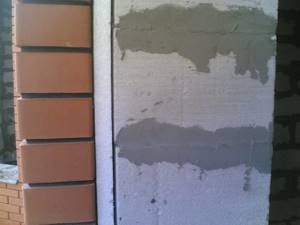
However, in this case, you can buy polystyrene foam with a minimum density of 5 cm wide, and the seams can be sealed with foam.
Is primer necessary after covering a house with foam plastic?
Polystyrene foam cannot be primed; most primers will corrode polystyrene foam. After attaching the foam boards to the wall using glue and dowels, you must perform the following steps:
How to glue polystyrene foam
Extruded polystyrene foam is a separate type of material, similar to polystyrene foam, but with its own differences. This is a synthetic board raw material that is produced by foaming a polymer composition at the time of extrusion. 95% of polystyrene foam consists of air. The material is light and perfectly retains heat, and also absorbs sounds.
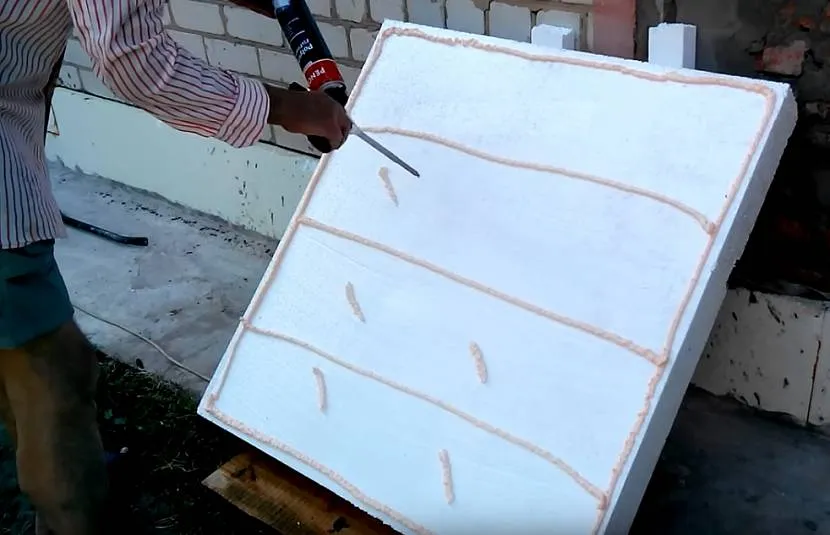
Regular polyurethane foam is suitable for fixation Source vikbud.ua
See also: Catalog of companies that specialize in finishing and paintwork materials
Expanded polystyrene is used to decorate the walls inside and outside the house. Polystyrene adhesive comes in different forms:
- polyurethane - suitable for gluing the material to concrete, stone, wood, brick, metal, expanded clay, plaster;
- adhesive foam – resistant to moisture and aging, used for insulating facades from the outside;
- cement-mineral - available in dry or ready-made form, resistant to frost, therefore used for insulating the external wall;
- based on modified bitumen - suitable for fixing the material on brick, metal, stone and wood, relevant for outdoor work.
Before using the adhesive, the slabs are cleaned of debris, and the walls are prepared for work - dust and dirt are removed. Then glue is applied to the slab, pressed tightly against the wall and left for several minutes. The plate is released, meanwhile the glue sets, so the master can already work with the next polystyrene plate.
Types of glue

How to glue extruded polystyrene foam and how to choose the right glue to perform this simple operation can be understood by considering the types of adhesive compositions.
Finding the required glue is not entirely easy. All adhesive compositions consist of several components.
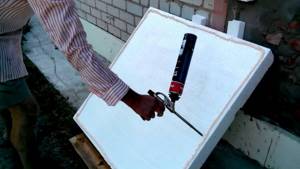
All types of glue stick panels well
Depending on this, they are divided into the following three main types:
- bitumen-based adhesive;
- polymer-cement glue;
- polyurethane foam glue.
All of these types have the properties necessary for gluing extruded polystyrene foam and provide quick setting and reliable adhesion of the bonded surfaces.
The adhesive for expanded polystyrene should not contain substances such as acetone and gasoline, because they corrode it, making it unsuitable for use, therefore, when choosing an adhesive, you need to make sure that it does not contain aggressive solvents, essential oils or similar substances.
How to glue foam together
It has already been found out how to glue foam plastic to other types of surfaces, but fixing two identical sheets also has its own nuances.
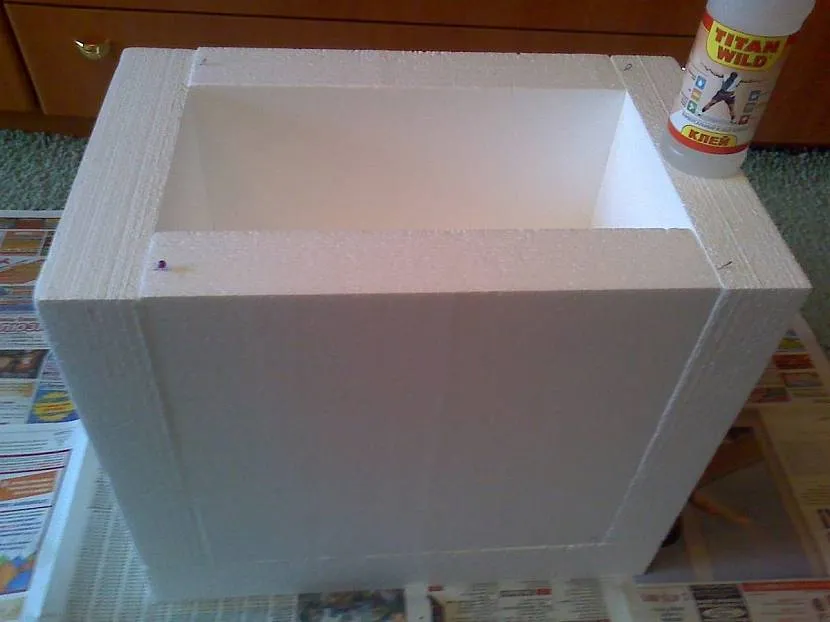
Polymer adhesives are suitable for fixing sheets together Source sevparitet.ru
There are several compounds that help with fastening:
- Liquid nails are a strong composition, so specialists connect the parts as smoothly as possible.
- Polyurethane spray - sprays evenly onto the slab and sets quickly.
- Professional glue – ensures a strong seam.
- PVA is the most affordable option, suitable for interior decor.
- Polyurethane foam – fixation occurs within 40-60 minutes.
Before gluing the foam together, builders clean the material from dust and wipe it with a dry rag. Next, prepare the walls, making them smooth and uniform. Two slabs of polystyrene foam are covered with glue and fixed one by one on the wall. Press down a little and wait until the solution sets. The optimal time that craftsmen use to press the slabs is 60 seconds, then the material is left to dry.
Features of installation of polystyrene foam
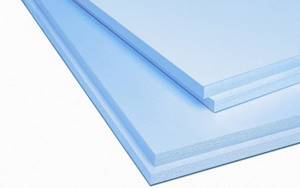
The structure of this product is high-density foam material. This distinguishes it from foam plastic, a common material also used in construction.
In contrast, EPPS passes through an extruder at the manufacturing stage, due to which the thermal insulation characteristics increase. The output is a technologically advanced fabric with polymers and small air bubbles.
“It is quite difficult to apply ordinary glue to the smooth surface of polystyrene foam insulation, which makes it difficult to bond to other surfaces.
This problem can be solved by selecting a special glue whose characteristics include a high degree of adhesion to any material.
It must be taken into account that some compositions dissolve the top layer of foam, impregnating them."
Let's look at the features of installing polystyrene foam boards:
- to insulate floors, slabs of expanded polystyrene are first laid on a layer of expanded clay or other durable, but not thick material, and completely filled with concrete;
- the foundation layer is insulated by attaching slabs to a concrete structure and secured with fasteners;
- before laying the roof, EPS is first laid, then a layer of bitumen is poured or slabs are placed between the internal rafters under the roof;
- if the ceiling is insulated from the inside of the building, polystyrene foam is first laid on the attic roof, then filled with concrete or filled with fine expanded clay or gravel chips.
Foam plastic as a basis for adhesives
A strong adhesive is made from polystyrene foam or expanded polystyrene to hold surfaces together. This composition can also be used as a paint or protective varnish. Based on small, light balls, the adhesive solution is strong and reliable.
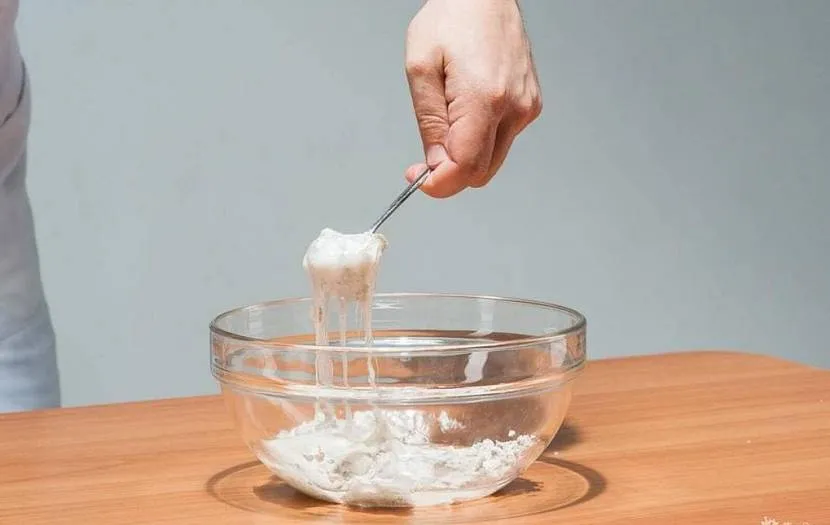
Foam material produces a powerful fixing mixture Source i1.wp.com
Polystyrene foam adhesive
This solution has good adhesive properties and is used in the following cases:
- for sealing cracks and joints in the roof;
- for gluing interior items;
- for decoration of household products;
- for fixing ceiling plinths;
- for joining individual pieces of polystyrene foam.
Styrofoam glue becomes a lifesaver when there is no construction adhesive nearby. Experts make it themselves. They take a solvent such as xylene, acetone or gasoline. Gasoline dissolves foam perfectly, so it is considered the optimal component for glue. Then take pieces of polystyrene foam or expanded polystyrene: the larger they are, the more viscous the finished solution is. Polystyrene foam is gradually placed in a jar of solvent and the workpiece is stirred. As soon as the glue is ready, it is immediately used for its intended purpose.

The solvent instantly corrodes the foam Source mauro-gianvanni.ru
This composition is not stored for a long time, so it must be used immediately. Glue is applied to the surface and the desired material is glued. Experts make sure that there are no smudges on the product: ingrained composition is very difficult to wipe off after it dries.
Bitumen based adhesive

Bitumen adhesive does not need to be heated before application
Bitumen adhesive is a plaster-adhesive mixture in which bitumen is used as a binder. It goes well with polystyrene foam and bonds it well to the surface being glued. Bitumen adhesive is plastic and does not require preheating before use.
Due to the content of bitumen in the adhesive, the surface covered with extruded polystyrene foam, provided that the adhesive is carefully applied to the surface of the materials, has high waterproofing qualities.
Related article: DIY flower pot design

This allows the use of this technology when insulating foundations, ground floor floors with polyurethane materials, when laying floors on the ground and in other cases when extruded polystyrene foam is used in structures exposed to moisture.
For high-quality adhesion of the bonded surfaces, it is necessary to pay attention to the application of the adhesive composition to the surface of the materials. It is distributed in a small even layer using a comb spatula.
This will not only firmly connect the materials used, but will also ensure the creation of a high-quality waterproofing layer between them. After this, you need to create a certain pressure on the materials being glued together for half an hour. This can be done using spacers, clamps or other available methods.
Preparation of bitumen-based adhesive does not require much effort and is carried out in a matter of minutes using an electric drill with an attachment in the volumes necessary for high-quality work.
Plaster and adhesive mixtures
Designed for connecting expanded polystyrene slabs to cardboard and cinder block surfaces, and for fastening to brick and concrete walls. Before use, dry mixtures must be diluted to the consistency specified in the instructions.
As a rule, they include various components consisting of mineral additives, plasticizers, Portland cement and other additives.
Although they help to hide many unevenness in the work, they require high-quality priming of the bases. Let us give an example of such mixtures.
Ceresit CT-83

"Ceresit ST-83" is mainly used for facade work with expanded polystyrene. The product tolerates low temperatures and has good adhesion to wood, concrete, plaster, and brick. After drying it becomes airtight.
Quite an economical product per square meter, since it is applied no more than one centimeter thick with a notched trowel. The manufacturer also produces a brand of glue “Ceresit ST-85”, which is more universal.
Polymer additives in the composition provide significant strength and elasticity, but such a mixture will cost more than ST-83.
The application technique for both brands is the same - applied in small sections, indented from the edges to allow air to be expelled.
Bergauf ISOFIX
The brand includes mineral components, various fillers, cement and sand fillers, plasticizers and special additives in the dry mixture.
It is used for both interior and facade decoration. Makes it possible to combine EPS with any types of materials.
Consumption is up to five and a half kilograms per sq.m., which is considered average consumption. There is no need to apply a thick layer, three centimeters is enough. You can work with the finished mixture for no more than one and a half hours, then its properties decrease.
If there is a need to correct the position of the slabs, this can be done within twenty-five minutes from the moment of gluing. They are packaged weighing twenty-five kilograms.
Technology for gluing foam plastic (extruded foam plastic) to the wall
So, we figured out what to glue (glue or mastic with the above properties), but we’ll look at the technology itself below:
- As always, work will begin by preparing our surface. First you need to remove everything that doesn’t adhere well, it could be old plaster or paint. Then we clean it from dust, dirt, stains, etc.
- To carry out the work, we choose a warm season, spring, summer, autumn. And, of course, it’s also hard to work in wind and rain. Therefore, we try to choose a time with favorable weather conditions.
- If we are insulating a wall, then we install a starting strip to hold the first rows of insulation. For vertical and horizontal surfaces, we prepare supports and loads accordingly.
- We prime the cleaned surface to improve adhesion with adhesive mixtures.
- Apply the adhesive mixture to the slabs with a notched trowel over the entire surface or so that the adhesive is applied to more than 50% of the insulation surface.
- We glue the insulation boards evenly to the surface so that in the future the plaster will lay down in an even layer.
- Don’t forget to additionally secure the insulation sheets with façade dowels.
- Since polystyrene foam is still a flammable material, air circulation is necessary when working with it in enclosed spaces.
Polystyrene gluing technology
To glue different brands of EPS boards, bitumen mastics or cement-based adhesives or polyurethane foam can be used. The glue base should not contain gasoline, ethers, acetone and other organic compounds - they damage it, literally dissolving it and leaving holes in the areas of application. In addition, the choice of adhesive for polystyrene foam depends on what exactly is being insulated: the floor of the building, its walls or ceiling.
In new low-rise buildings, it is recommended to design hollow walls and lay EPS boards inside them - there will be savings on adhesive and reinforcing elements. Work on installing thermal insulation with extruded polystyrene foam should be carried out in dry weather at an ambient temperature of at least +5 °C. The only exception is polyurethane foam.
When insulating the walls or floor of a building, polystyrene foam adhesive is the best choice. It is used simultaneously for gluing and reinforcement. Gluing of EPS boards begins from the bottom, laying them in 1 row. Next, they are fastened with a T-shaped seam dressing, close to each other and to the slabs of the adjacent row. It is unacceptable to re-install or change the position of the plate after 5 minutes after installation. Eps boards are fixed with dowels. For use in brick or concrete walls, take a dowel with a spacer of 60 mm, for walls made of cellular concrete and perforated brick - 90 mm. Quantity per sheet: 4-6 pcs., in the corners of the building up to 8 pcs. The reinforcing mesh is fixed tightly over the applied layer of glue; an overlap of 10 cm is made at the joints of the mesh pieces. After the first layer has hardened, the second is applied. The total thickness of the reinforcement must be at least 3 mm. Corner areas are protected from damage by aluminum corners. The final plaster layer is applied 3 days after reinforcement.
How to glue Penoplex
Special liquid mixtures
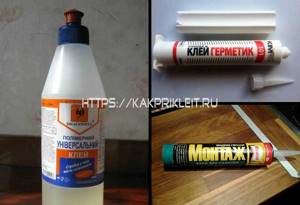
The glue is made on the basis of polyurethane. As a supplement, additives and thickeners of a denser consistency are used. Products are sold in polyethylene tubes.
The solution is used for interior work in construction, for decorating partitions, ceiling structures, and other polystyrene foam parts. The composition is also suitable for external insulation of buildings, as it is resistant to temperature and humidity.
The main disadvantage is the complexity that may arise during the application process. Problems can be noticed during operation at temperatures close to zero.
Polyurethane products
Any polyurethane adhesive is seriously different from the dry mixtures described above. They are often called “glue-foam”, “foam-glue”, because the compositions are sold in cylinders, and to use them you need a construction gun. They are used in the same way as polyurethane foam. Polyurethane adhesives for EPS are usually used for exterior applications; they have strong adhesion and are easy to use. The products dry quickly, are economical, do not react to changes in weather, and are frost-resistant.
Tytan Styro 753 GUN
Produced in 750 ml bottles, suitable even for interior work. This polystyrene adhesive is applied in thin strips, then the material is immediately applied to the wall. It can attach EPS to a base made of plaster, concrete, wood, mastic, cement, and is capable of reliably gluing sheets of expanded polystyrene together.
TechnoNIKOL adhesive is widely used for fastening polystyrene slabs to foundations, walls of houses, roofs, in basements, and on floors. The gaps between the insulation boards are also sealed with glue. The adhesion of the product is high even where there is mold, high humidity, and fungus.
The product is considered effective for fastening EPS slabs to bases made of concrete, aerated concrete, brick, and ceramic blocks. Packaged in standard 750 ml bottles. It is characterized by high strength, the quality of adhesion to the base is one of the best among analogues. The adhesive is incompatible with bitumen compositions, polyethylene film, and Teflon.
